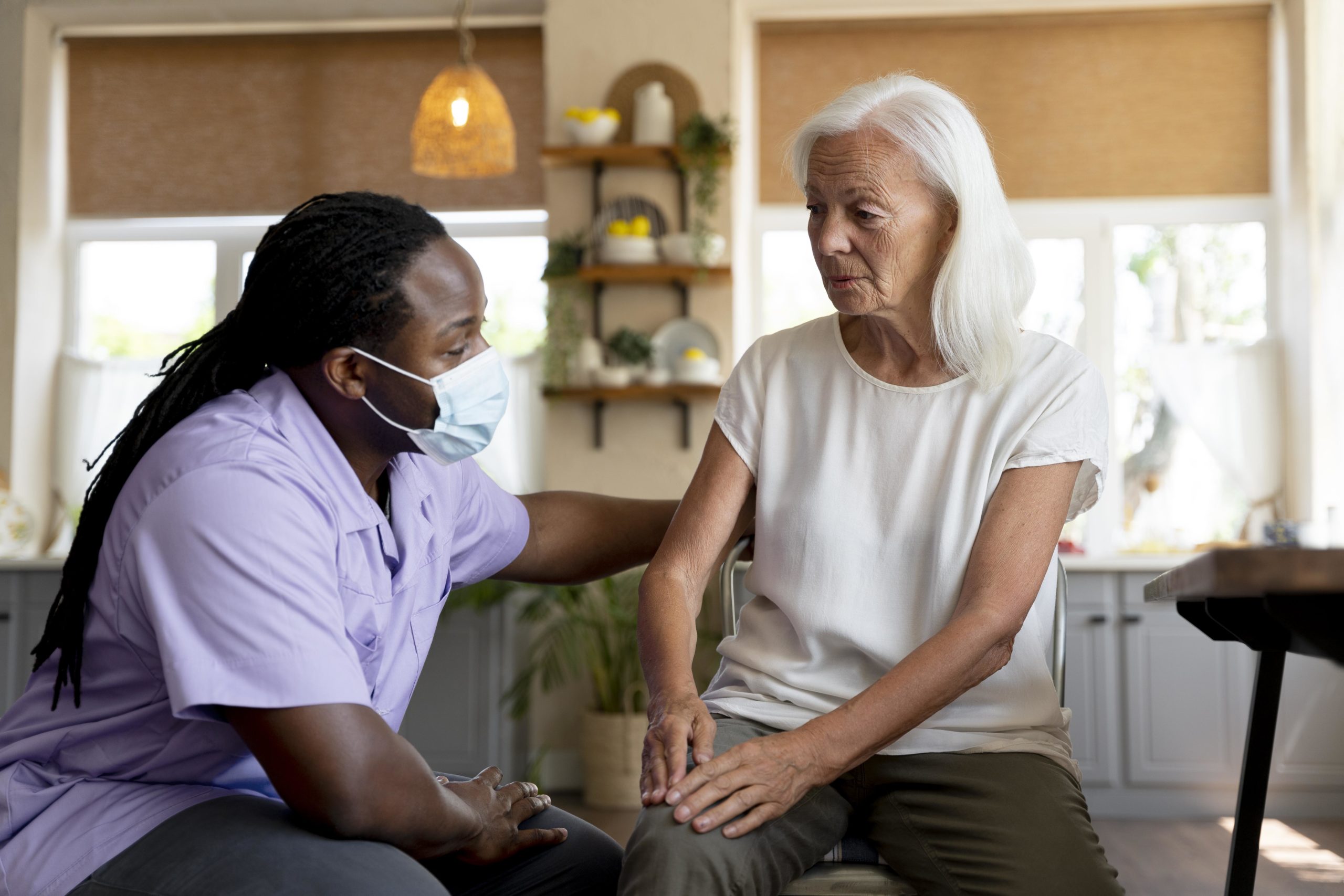A fall can be a symptom of a new or worsening health problem. It is a call to action – an opportunity to prevent another fall, perhaps with more serious consequences. Anyone can fall, but the chances of falling increase with age and someone who has had a fall is more likely to fall again. Each year, one in three people aged over 65 have a fall and over half of those over 80 have a fall. But falls are not inevitable and research indicates that for older people living at home, around 30% can be prevented. A FALL IN AN OLDER PERSON, EVEN WITHOUT ANY RELATED INJURY, SHOULD ALWAYS BE TAKEN SERIOUSLY. The chances of a fall causing serious and/or long term health problems increases with age. Falls are the leading cause of accidental death in older people. Falls cause injuries such as bruising, cuts, head injuries and fractured bones. The likelihood and severity of injury relates to a variety of factors including bone health, frailty and low body weight. Public Health England data indicate that 5% of falls result in a fracture. The most common fractures are to the wrist and the hip. Hip fractures can have a very serious impact on survival, disability and independence. People with low bone mineral density are more likely to experience a fracture following a fall. Osteoporosis is a common cause of low bone mineral density. Unsurprisingly, many older people fear falling and falls can have a major impact on their mental health. Falls can cause older people to lose confidence in going about their day to day activities leading to depression, isolation or loss of independence. CAUSES OF FALLS Muscle weakness Poor balance Visual impairment Medication Fortunately, there is plenty you can do to minimise the risk of a fall or serious injury. It is common for local health and/or social services to help with a lot of actions to prevent falls including covering some of the additional expenses. Local arrangements will vary depending on the situation – at home a primary or community care team or local adult social care service could be involved. Hospital discharge arrangements will often include arrangements to minimise any future risk of a fall. BE POSITIVE AND SENSITIVE WHEN TACKLING THE ISSUE Older people are often reluctant to report a fall or involve a doctor because they fear their independence will be taken away from them. If tackled well however, the opposite is true – taking positive steps to prevent falls can help to maintain good health and independence. Understand the fear and broach the topic with tact and empathy.
HELPING WITH MEDICINES: REDUCING PRESCRIPTION ERRORS
It is easy for mistakes and errors to occur during the process of prescribing, dispensing, administering and taking different pills and medicines. This guide aims to help you understand how you can minimise the risks and increase medication safety for you and yours. MEDICATION ERRORS ARE COMMON Experts have shown that medication errors are common. A recent study found that around 237 million medication errors occur at some point in the medication process in England every year. Fortunately most of these errors (72%) cause minimal harm to patients and only a very small proportion (2%) cause severe harm. Nevertheless, that means that around one quarter of medication errors cause moderate harm, potentially leading to emergency hospital care. Errors can happen in any setting including at home, in the GP surgery, in hospital or in residential care. The frequency of errors does vary across settings. Although error rates are lowest in primary care, it deals with so much medication that it is responsible for 38.4% of all errors. By contrast, care homes deal with much fewer patients but have much higher error rates per patient resulting in a high proportion of all errors (41.7%). 19.9% of errors relate to hospital care. Administration related errors include: Giving medication to the wrong patient Giving the wrong medicine Giving the wrong dose Giving medicine the wrong way Failing to give the medicine at the right time or not at all Giving medicine to someone who is likely to be allergic or hypersensitive to it Mistakes can also occur at any stage although they are most likely to occur when a drug is prescribed (21.3%) or given/taken by a patient (54.4%) Prescription errors include: HIGH RISK MEDICATIONS Some medicines are especially dangerous if they are misused or used in error. Common medicines on the “high risk” list include: Warfarin and other anticoagulants Blood pressure lowering medicines Antiplatelet medicines including clopidogrel and common painkillers such as ibuprofen or diclofenac Paracetamol Medicines used to treat diabetes Some antibiotics Anticholinergic medicines in elderly and frail patients Morphine and other opioid based medicines Benzodiazepines such as temazepam or diazepam Lithium Clozapine
Information, guides and checklists to help families and carers understand and support someone living with dementia.
Dementia has many causes, all of which involve chronic widespread cognitive impairment (i.e. impaired memory, language, attention, thinking, orientation, calculation and problem-solving) associated with changes to functional abilities (such as dressing, driving, shopping, eating etc.) Ageing is the single greatest risk factor for the onset of most types of dementia. During the course of the illness, around 80% of those affected develop behavioral and psychological symptoms of dementia (BPSD) such as agitation, aggression, hallucinations, wandering and sleep disturbance. Many behavioral symptoms can be signs of distress – either due to psychotic experiences, discomfort, pain, or basic needs not being met. ONGOING HEALTH AND CARE FOR SOMEONE LIVING WITH DEMENTIA – A CHECKLIST KEY SOURCES OF SUPPORT TO HELP SOMEONE WITH DEMENTIA Alzheimer’s Society Dementia UK The Lewy Body Society The Brain Charity Data from Public Health England show that in England, around 4.3% of people aged 65 years or more have been diagnosed with dementia. Some people can remain undiagnosed for many years and so it’s likely that the figures underestimate the actual numbers and there are more people living with dementia than we recognise. THE CARENTS ROOM DEMENTIA CHECKLIST If your parent has been diagnosed with dementia, and you are helping to organise their health care, then this checklist summarises some of the issues you might want to discuss with them. The checklist is not a substitute for medical advice – always seek professional help. Remember healthcare professionals will not share information about a patient unless they have been given permission to do so.
A new strategy for the changing world of health and social care – CQC’s strategy from 2023
We’ll look at how the care provided in a local system is improving outcomes for people and reducing inequalities in their care. This means looking at how services are working together within an integrated system, as well as how systems are performing as a whole. We’re committed to our ambition of regulating to advance equality and protect people’s Human Rights. Everyone in health and social care has a role to play in tackling the inequalities in health and care for some people. This strategy sets out our ambition for how we can help influence change. We’re changing how we regulate to improve care for everyone. What we’ve learned from the past five years puts us in a better position for the future. Our new strategy combines this learning and experience and we’ve developed it with valuable contributions from the public, service providers and all our partners. It means our regulation will be more relevant to the way care is now delivered, more flexible to manage risk and uncertainty, and will enable us to respond in a quicker and more proportionate way as the health and care environment continues to evolve. This new strategy strengthens our commitment to deliver our purpose: to ensure health and care services provide people with safe, effective, compassionate, high-quality care and to encourage those services to improve. Our strategy is purposefully ambitious, and to implement it we will need to work closely with others to make it a reality. We’ll review this strategy regularly so we can adapt to changes and be prepared for what the future holds. Our purpose and our role as a regulator won’t change – but how we work will be different. We set out our ambitions under four themes People and communities: Smarter regulation: Safety through learning: Accelerating improvement: E We’ll look at how the care provided in a local system is improving outcomes for people and reducing inequalities in their care. This means looking at how services are working together within an integrated system, as well as how systems are performing as a whole. Core ambitions Running through each theme are two core ambitions: Assessing local systems: Providing independent assurance to the public of the quality of care in their area Tackling inequalities in health and care: Pushing for equality of access, experiences and outcomes from health and social care services Taking the right action at the right time We have a baseline understanding of quality across health and social care. But we know that the quality of care can vary from day to day. We’ll use our regulatory powers in a smarter, more proportionate and consistent way to make the right decisions and take the right action. Our assessments of quality will be different. On-site inspections are a vital part of our performance assessments and essential to observe the care people receive. But they are not the only way to assess quality: we want to move away from relying on a set schedule of inspections to a more flexible, targeted approach. To do this, we’ll use all our regulatory methods, tools and techniques to assess quality. We’ll build stronger relationships with services and with local systems. This includes having ongoing conversations about quality, which will give us a better insight and enable us to tailor our approach to be more proportionate. We’ll visit when there’s a clear need to do so. For example, this could be when we’re responding to risk, where we only have limited data or we need specific information, where we need to speak to people using the service face-to-face, or to ensure that our view of quality is reliable. For some types of service, we’ll need to visit more often to observe care. Our continuous insight and monitoring activity mean that rather than spending time looking at paperwork when we’re on site, we’ll be able to make the most of our time – we’ll have better conversations with people who live in or use the service, and their families and advocates, and more time to talk with staff. We’ll build digital platforms that will better integrate the data we hold, which will enable us to interpret data in a more consistent way. We’ll use innovative analysis, artificial intelligence and data science techniques proactively to support robust and proportionate decision-making, based on the best information available.
24 Hour Live In Care
24 hour live in care enables anyone with care needs to continue living in their house with a team of around-the-clock live in carers. We know it can be challenging when your loved ones are getting to an age where they can’t take of themselves any longer, and you don’t have the time to be able to care for them. Finding a way to get the care they need can be painfully tricky because you want to ensure they will get the very best care available so that you feel comfortable leaving them with someone. Embracing personal care, housekeeping, and companionship is a natural alternative to residential care that empowers you to retain control and independence. Your professional live-in carer works with you to meet your personal needs and wishes, following an individually designed support plan that is put together by one of our local assessors in conjunction with those familiar with existing routines and needs. Your care is arranged on your terms and is designed to meet current preferences; whether you need some companionship or have specific health issues requiring extra support, 24-hour live-in care provides a realistic and affordable alternative. We can ensure you get specialist care from highly qualified and experienced carers across the UK. What Is 24 Hour Live In Care? Carers will help with all manner of tasks. Some of the more common include: Getting Up / Going to Bed Medication Cooking Meals & Cleaning Laundry – clothes & bed linen Laundry – clothes & bed linen 24-Hour Live In Care is an excellent, cost-effective alternative to a residential or nursing home, enabling you to retain control and independence. A live-in carer lives with you in your own house and allows you, or your loved one, to stay home in familiar and relaxed surroundings. 24 Hour Live In Care Frequently Asked Questions What is 24 hour live in care? 24-hour live in care is particularly suitable for those with medical conditions that require around the clock live in care and treatment such as Parkinson’s (timed medication) or clients that need to be turned in every four hours. In this instance, two or more live-in carers would split the 24-hour shift to ensure care is provided at all times of the day. Live In Care involves one live in carer who works up to 10 – 12 hours per day and then is available for ad hoc care needs through the night; if the care needs to increase, your loved one may need 24-hour care. How much is 24 hour live in care? Our Packages of 24 hour live in care are bespoke and dependent on the care needs and requirements. Contact us today to find out more How do I find a 24 hour live in carer? Please Contact us today to find out more on how we can make a real difference to your life





